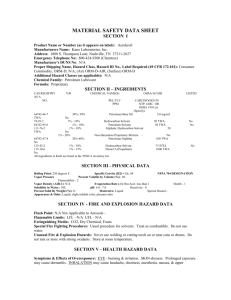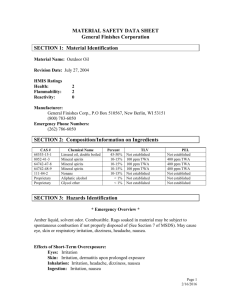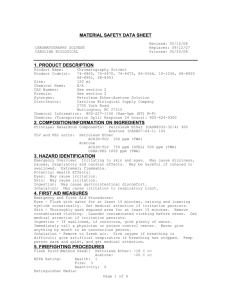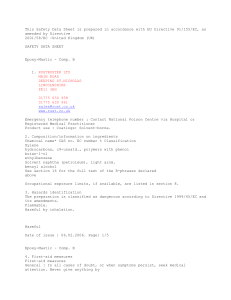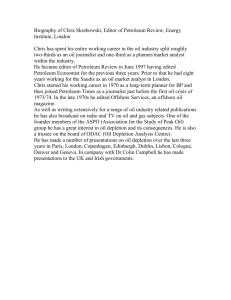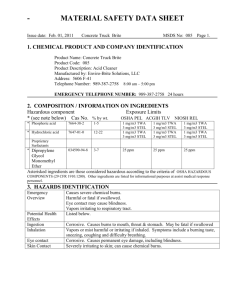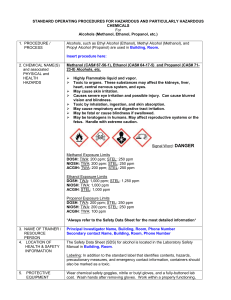Petroleum Ether
advertisement
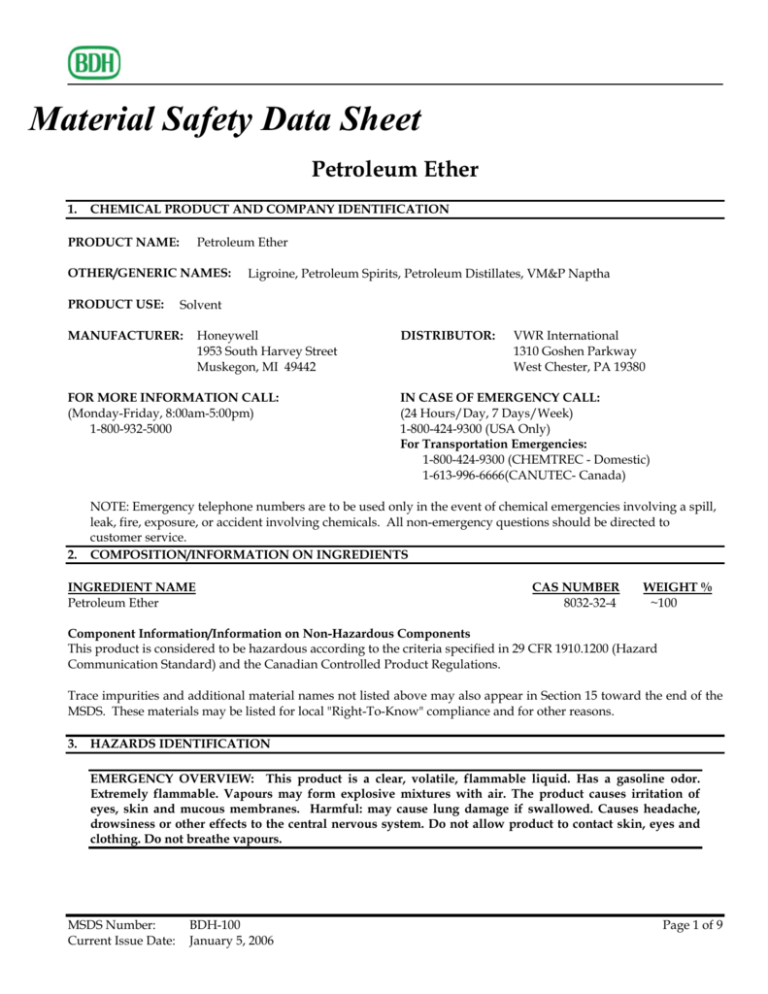
Material Safety Data Sheet Petroleum Ether 1. CHEMICAL PRODUCT AND COMPANY IDENTIFICATION PRODUCT NAME: Petroleum Ether OTHER/GENERIC NAMES: PRODUCT USE: Ligroine, Petroleum Spirits, Petroleum Distillates, VM&P Naptha Solvent MANUFACTURER: Honeywell 1953 South Harvey Street Muskegon, MI 49442 FOR MORE INFORMATION CALL: (Monday-Friday, 8:00am-5:00pm) 1-800-932-5000 2. DISTRIBUTOR: VWR International 1310 Goshen Parkway West Chester, PA 19380 IN CASE OF EMERGENCY CALL: (24 Hours/Day, 7 Days/Week) 1-800-424-9300 (USA Only) For Transportation Emergencies: 1-800-424-9300 (CHEMTREC - Domestic) 1-613-996-6666(CANUTEC- Canada) NOTE: Emergency telephone numbers are to be used only in the event of chemical emergencies involving a spill, leak, fire, exposure, or accident involving chemicals. All non-emergency questions should be directed to customer service. COMPOSITION/INFORMATION ON INGREDIENTS INGREDIENT NAME Petroleum Ether CAS NUMBER 8032-32-4 WEIGHT % ~100 Component Information/Information on Non-Hazardous Components This product is considered to be hazardous according to the criteria specified in 29 CFR 1910.1200 (Hazard Communication Standard) and the Canadian Controlled Product Regulations. Trace impurities and additional material names not listed above may also appear in Section 15 toward the end of the MSDS. These materials may be listed for local "Right-To-Know" compliance and for other reasons. 3. HAZARDS IDENTIFICATION EMERGENCY OVERVIEW: This product is a clear, volatile, flammable liquid. Has a gasoline odor. Extremely flammable. Vapours may form explosive mixtures with air. The product causes irritation of eyes, skin and mucous membranes. Harmful: may cause lung damage if swallowed. Causes headache, drowsiness or other effects to the central nervous system. Do not allow product to contact skin, eyes and clothing. Do not breathe vapours. MSDS Number: Current Issue Date: BDH-100 January 5, 2006 Page 1 of 9 MATERIAL SAFETY DATA SHEET Petroleum Ether POTENTIAL HEALTH HAZARDS SKIN: Irritating to skin. Repeated or extended contact may cause erythema (reddening of the skin) or dermatitis, resulting from a defatting action on tissue. EYES: Irritating to eyes. Symptoms include itching, burning, redness and tearing. INHALATION: Vapours may cause drowsiness and dizziness. Inhalation of high vapour concentrations can cause CNS-depression and narcosis. Severe overexposure may produce more serious symptoms, including coma and risk of kidney damage. INGESTION: Harmful: may cause lung damage if swallowed. Ingestion of this product may result in central nervous system effects including headache, sleepiness, dizziness, slurred speech and blurred vision. DELAYED EFFECTS: Repeated or prolonged exposure may cause conjunctivitis and damage to the respiratory tract and kidney. MEDICAL CONDITIONS AGGRAVATED BY EXPOSURE: Pre-existing respiratory or kidney dysfunctions, or central nervous system disorders may be aggravated by exposure. HMIS Ratings: Health: 2 Fire: 4 Physical Hazard: 0 Hazard Scale: 0 = Minimal 1 = Slight 2 = Moderate 3 = Serious 4 = Severe * = Chronic hazard Ingredients found on one of the OSHA designated carcinogen lists are listed below. INGREDIENT NAME Petroleum Ether (8032-32-4) Petroleum Ether (8032-32-4) ACGIH: 4. NTP STATUS None IARC STATUS None OSHA LIST None A3 - Confirmed animal carcinogen with unknown relevance to humans FIRST AID MEASURES SKIN: Wash off immediately with soap and plenty of water. Take off contaminated clothing and shoes immediately. Wash contaminated clothing before re-use. Obtain medical attention. EYES: Rinse immediately with plenty of water, also under the eyelids, for at least 15 minutes. Obtain medical attention. INHALATION: Move to fresh air in case of accidental inhalation of vapours. If not breathing, give artificial respiration. If breathing is difficult, give oxygen, provided a qualified operator is available. Call a physician immediately. MSDS Number: BDH-100 Current Issue Date: January 5, 2006 Page 2 of 9 MATERIAL SAFETY DATA SHEET Petroleum Ether INGESTION: DO NOT induce vomiting. Immediate medical attention is required. If vomiting occurs naturally, have victim lean forward to reduce risk of aspiration. ADVICE TO PHYSICIAN: 5. Treat symptomatically. FIRE FIGHTING MEASURES FLAMMABLE PROPERTIES FLASH POINT: 55°F (13°C) FLASH POINT METHOD: Closed Cup AUTOIGNITION TEMPERATURE: 550°F (228°C) UPPER FLAME LIMIT (volume % in air): 5.9 LOWER FLAME LIMIT (volume % in air): 1.1 FLAME PROPAGATION RATE (solids): Not applicable OSHA FLAMMABILITY CLASS: Class 1A Flammable Liquid EXTINGUISHING MEDIA: Use regular foam, carbon dioxide (CO2) or dry chemical. UNUSUAL FIRE AND EXPLOSION HAZARDS: Extremely flammable. Vapours may form explosive mixtures with air. Vapours are heavier than air and may travel along the ground to some distant source of ignition and flash back. Hazardous combustion products may include carbon monoxide, carbon dioxide (CO2). SPECIAL FIRE FIGHTING PRECAUTIONS/INSTRUCTIONS: Water may be ineffective. Do not use a solid water stream as it may scatter and spread fire. Fire or intense heat may cause violent rupture of packages. Fire-fighters should wear self-contained, NIOSH-approved breathing apparatus and full protective clothing. Fire or intense heat may cause violent rupture of packages. In the event of fire, cool tanks with water spray. Do not allow run-off from fire fighting to enter drains or water courses. NFPA Ratings: Health: 2 Fire: 4 Reactivity: 0 Hazard Scale: 0 = Minimal 1 = Slight 2 = Moderate 3 = Serious 4 = Severe 6. ACCIDENTAL RELEASE MEASURES IN CASE OF SPILL OR OTHER RELEASE: Containment Procedures: Use personal protective equipment. Ensure adequate ventilation. Remove all sources of ignition. Stop flow of material, if this is without risk. Cleanup Procedures: Soak up with inert absorbent material (e.g. sand, silica gel, acid binder, universal binder, sawdust). Shovel into suitable container for disposal. Do not use sparking tools. Do not allow product to enter sewer or waterways. Evacuation Procedures: Keep unnecessary people away. Isolate area. Special Procedures: Use personal protective equipment. MSDS Number: BDH-100 Current Issue Date: January 5, 2006 Page 3 of 9 MATERIAL SAFETY DATA SHEET Petroleum Ether Spills and releases may have to be reported to Federal and/or local authorities. See Section 15 regarding reporting requirements. 7. HANDLING AND STORAGE NORMAL HANDLING: (Always wear recommended personal protective equipment.) Ensure all equipment is electrically grounded before beginning transfer operations. Ensure adequate ventilation. Do not allow product to contact skin, eyes and clothing. Do not breathe vapours. Keep away from fire, sparks and heated surfaces. Keep container tightly closed in a dry and well-ventilated place. Ensure at or below room temperature before opening containers. STORAGE RECOMMENDATIONS: Keep in a well-ventilated place. Empty containers may retain product residue including Flammable or Explosive vapours. Do not cut, drill, grind, or weld near full, partially full, or empty product containers. Keep away from heat and sources of ignition. Store away from incompatible substances. Re-open used containers with caution. Containers which are opened must be carefully resealed and kept upright to prevent leakage. Store in area designed for storage of flammable liquids. Protect from physical damage. 8. EXPOSURE CONTROLS/PERSONAL PROTECTION ENGINEERING CONTROLS: Provide local and general exhaust ventilation to effectively remove and prevent buildup of any vapours or mists generated from the handling of this product or use product only in closed system. Local exhaust ventilation is preferred. Prevent electrostatic charge build-up by using common bonding and grounding techniques. PERSONAL PROTECTIVE EQUIPMENT SKIN PROTECTION: Wear impervious gloves and flame retardant antistatic protective clothing. Gloves must be inspected prior to use. For leak, spills, or other emergency, use full protective equipment. EYE PROTECTION: For handling in closed ventilation system, wear safety glasses with side-shields. For leak, spill or other emergency, use chemical goggles and face-shield. Remove contact lenses. RESPIRATORY PROTECTION: When workers are facing concentrations above the exposure limit they must use appropriate certified respirators. For emergency operations, wear self contained breathing apparatus. ADDITIONAL RECOMMENDATIONS: Provide eyewash stations and quick-drench shower facilities. High standards of skin care and personal hygiene should be exercised at all times. MSDS Number: BDH-100 Current Issue Date: January 5, 2006 Page 4 of 9 MATERIAL SAFETY DATA SHEET Petroleum Ether EXPOSURE GUIDELINES Component Exposure Limits Petroleum Ether (8032-32-4) ACGIH: 300 ppm TWA OSHA (Vacated): 300 ppm TWA; 1350 mg/m3 TWA 400 ppm STEL; 1800 mg/m3 STEL NIOSH: 350 mg/m3 TWA 1800 mg/m3 Ceiling (15 min) Alberta: 300 ppm TWA; 1398 mg/m3 TWA British Columbia: 300 ppm TWA Manitoba: 300 ppm TWA; 1350 mg/m3 TWA New Brunswick: 300 ppm TWA; 1370 mg/m3 TWA Northwest Territories: 300 ppm TWA; 1350 mg/m3 TWA 400 ppm STEL; 1800 mg/m3 STEL Nova Scotia: 300 ppm TWA Nunavut: 300 ppm TWA; 1350 mg/m3 TWA 400 ppm STEL; 1800 mg/m3 STEL Ontario: 500 mg/m3 TWAEV; 1350 mg/m3 TWAEV (listed under VM&P Naphtha) Quebec: 300 ppm TWAEV; 1370 mg/m3 TWAEV Saskatchewan: 1370 mg/m3 TWA; 300 ppm TWA 1712 mg/m3 STEL; 375 ppm STEL 9. PHYSICAL AND CHEMICAL PROPERTIES APPEARANCE: Clear, colorless liquid PHYSICAL STATE: Liquid MOLECULAR WEIGHT: Not determined CHEMICAL FORMULA: Mixture of paraffins, naphthas, and other hydrocarbons ODOR: Gasoline-like SPECIFIC GRAVITY (water = 1.0): 0.64 g/mL @ 68°F(20°C) SOLUBILITY IN WATER (weight %): 0.04% @ 68°F(20°C) pH: Not applicable BOILING POINT: 95-140°F (35-60°C) MELTING POINT: <-99.4°F (<-73°C) VAPOUR PRESSURE: 40 mm Hg @ 68°F(20°C) VAPOUR DENSITY (air = 1.0): 3.0 EVAPORATION RATE: >10 COMPARED TO: Butyl Acetate = 1 % VOLATILES: 100 FLASH POINT: 55°F (13°C) (Flash point method and additional flammability data are found in Section 5.) MSDS Number: BDH-100 Current Issue Date: January 5, 2006 Page 5 of 9 MATERIAL SAFETY DATA SHEET Petroleum Ether 10. STABILITY AND REACTIVITY NORMALLY STABLE? (CONDITIONS TO AVOID): Stable under recommended storage conditions. Avoid: Heat, flames and sparks. Incompatible products INCOMPATIBILITIES: Avoid acids, bases, oxidizers, explosives, nitrogen-fluoride compounds, sulfites and perchlorates. HAZARDOUS DECOMPOSITION PRODUCTS: Hazardous decomposition products include carbon monoxide and carbon dioxide (CO2). HAZARDOUS POLYMERISATION: Hazardous polymerisation does not occur. 11. TOXICOLOGICAL INFORMATION Component Analysis - LD50/LC50 Petroleum Ether (8032-32-4) Rat: LD50 – Route: Inhalation; Dose: 3400 ppm/4H IMMEDIATE (ACUTE) EFFECTS: The product causes irritation of eyes, skin and mucous membranes. Harmful: may cause lung damage if swallowed. Causes headache, drowsiness or other effects to the central nervous system. DELAYED (SUBCHRONIC AND CHRONIC) EFFECTS: Repeated or prolonged exposure may cause conjunctivitis and damage to the respiratory tract and kidney. Repeated or extended contact may cause erythema (reddening of the skin) or dermatitis, resulting from a defatting action on tissue. OTHER DATA: Petroleum ether is classified by ACGIH as Class 3, confirmed animal carcinogen with unknown relevance to humans. This material is not known or reported to be carcinogenic by any reference source including IARC, OSHA, NTP, or EPA. Component Carcinogenicity Petroleum Ether (8032-32-4) ACGIH: A3 - Confirmed animal carcinogen with unknown relevance to humans 12. ECOLOGICAL INFORMATION Prevent from entering sewer or waterway. Component Analysis - Ecotoxicity - Aquatic Toxicity No ecotoxicity data are available for this product's components. MSDS Number: BDH-100 Current Issue Date: January 5, 2006 Page 6 of 9 MATERIAL SAFETY DATA SHEET Petroleum Ether Bioaccumulation potential in aquatic organisms is moderate. Volatilization from moist soil surfaces is expected to be an important fate process. 13. DISPOSAL CONSIDERATIONS WASTE INFORMATION: This product is a D001 ignitable waste in supplied form. Dispose of as special waste in compliance with local and national regulations. Waste codes should be assigned by the user based on the application for which the product was used. Incineration of waste material in an EPA-approved facility is recommended, allowing a solid, inert residue to form. OTHER DISPOSAL CONSIDERATIONS: Observe all Federal, State, and Local Environmental regulations. The information offered here is for the product as shipped. Use and/or alterations to the product such as mixing with other materials may significantly change the characteristics of the material and alter the RCRA classification and the proper disposal method. 14. TRANSPORT INFORMATION US DOT PROPER SHIPPING NAME: Petroleum distillates, n.o.s. (Petroleum Ether) US DOT HAZARD CLASS: 3 PACKING GROUP: I US DOT ID NUMBER: UN1268 TDG PROPER SHIPPING NAME: Petroleum distillates, n.o.s. (Petroleum Ether) TDG HAZARD CLASS: PACKING GROUP: I 3 TDG ID NUMBER: UN1268 North American Emergency Response Guide (ERG) Number: 128 For additional information on shipping regulations affecting this material, contact the information number found in Section 1. 15. REGULATORY INFORMATION TOXIC SUBSTANCES CONTROL ACT (TSCA) TSCA INVENTORY STATUS: All components are on the U.S. EPA TSCA Inventory List. OTHER TSCA ISSUES: TSCA IUR 2006, Partially Exempt Petroleum Process Streams (40 CFR 710.46(b)(1)) TSCA High Production Volume (HPV) Chemicals: 1990, 1994 & Post-1994 Additions (01/31/05). MSDS Number: BDH-100 Current Issue Date: January 5, 2006 Page 7 of 9 MATERIAL SAFETY DATA SHEET Petroleum Ether SARA TITLE III/CERCLA "Reportable Quantities" (RQs) and/or "Threshold Planning Quantities" (TPQs) exist for the following ingredients. INGREDIENT NAME SARA/CERCLA RQ (lb) SARA EHS TPQ (lb) No ingredients in this section. None None Spills or releases resulting in the loss of any ingredient at or above its RQ requires immediate notification to the National Response Center [(800) 424-8802] and to your Local Emergency Planning Committee. SECTION 311 HAZARD CLASS: Immediate. Delayed. Fire. SARA 313 TOXIC CHEMICALS: The following ingredients are SARA 313 "Toxic Chemicals". CAS numbers and weight percents are found in Section 2. INGREDIENT NAME No ingredients listed in this section. COMMENT None STATE RIGHT-TO-KNOW In addition to the ingredients found in Section 2, the following are listed for state right-to-know purposes. INGREDIENT NAME Petroleum Ether (8032-32-4) WEIGHT % 100 COMMENT MN, NJ, PA ADDITIONAL REGULATORY INFORMATION: None. WHMIS CLASSIFICATION (CANADA): This product has been classified in accordance with the hazard criteria of the Controlled Products Regulations (CPR) and the MSDS contains all information required by CPR. WHMIS Classification: B2- Flammable Liquid D2B- Toxic Material FOREIGN INVENTORY STATUS: Component Analysis - Inventory Component CAS # TSCA Petroleum Ether 8032-32-4 Yes CAN DSL EEC EINECS AUST Yes PHIL Yes MITI No KOREA Yes CHINA Yes 16. OTHER INFORMATION CURRENT ISSUE DATE: PREVIOUS ISSUE DATE: January 5, 2006 New MSDS. MSDS Number: BDH-100 Current Issue Date: January 5, 2006 Page 8 of 9 MATERIAL SAFETY DATA SHEET Petroleum Ether CHANGES TO MSDS FROM PREVIOUS ISSUE DATE ARE DUE TO THE FOLLOWING: New MSDS. OTHER INFORMATION: KEY/LEGEND: As per the OSHA Hazard Communication Standard, 1910.1200, the information contained within this MSDS must be given to those persons using this material. For laboratory use only. Not for food or drug use. Do not store with foodstuffs. ACGIH = American Conference of Governmental Industrial Hygienists; CAS = Chemical Abstracts Service; CERCLA = Comprehensive Environmental Response, Compensation, and Liability Act; CFR = Code of Federal Regulations; CPR = Controlled Products Regulations; DOT = Department of Transportation; DSL = Domestic Substances List; EINECS = European Inventory of Existing Commercial Chemical Substances; EPA = Environmental Protection Agency; IARC = International Agency for Research on Cancer; IATA = International Air Transport Association; mg/Kg = milligrams per Kilogram; mg/L = milligrams per Liter; mg/m3 = milligrams per Cubic Meter; MSHA = Mine Safety and Health Administration; NA = Not Applicable or Not Available; NIOSH = National Institute for Occupational Safety and Health; NJTSR = New Jersey Trade Secret Registry; NTP = National Toxicology Program; OSHA = Occupational Safety and Health Administration; SARA = Superfund Amendments and Reauthorization Act; TDG = Transport Dangerous Goods; TSCA = Toxic Substances Control Act; WHMIS = Workplace Hazardous Materials Information System. End of Sheet #BDH-100 MSDS Number: BDH-100 Current Issue Date: January 5, 2006 Page 9 of 9
